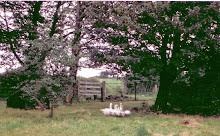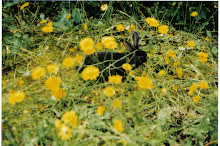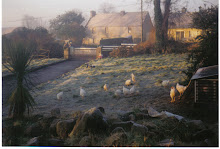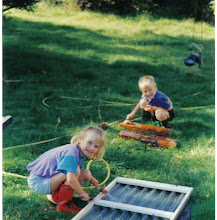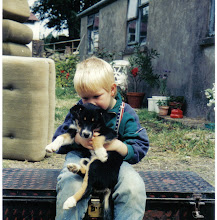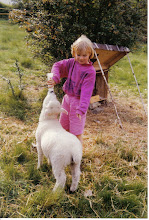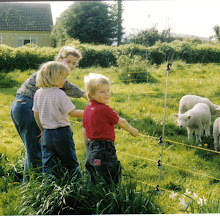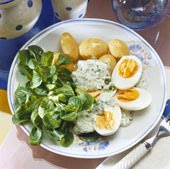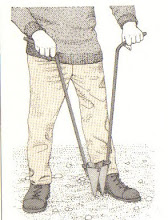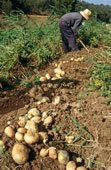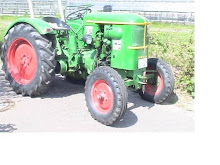Triggered off by an inquiry from one of my Followers (!), I’m postponing my compost story (yawn) and also fashion advice for the trendy farmer's woman (shame). We started with about a dozen brown chickens. Laying hens are called pullets. We asked the farmer we bought them from whether they were laying already or not, because it can take up to 6 months until they do -- depending on the breed. Now my dear friend, not knowing how old or what your breed is, I venture to say that, just like girls, chicks start to mature and reach puberty at different times. One of them may well be laying already, as you wrote, whereas the others are still growing and getting ready to produce a life-long supply of your eggs. These pullets, when they are older and past laying, can still be used for nutritious soup. You wouldn’t roast them, because they would be too tough. You want broilers for roasting.
Some hens lay an egg every day, some skip a day. In Ireland, they reduced their production in winter. Even if yours are home in a milder climate, their circadian rhythm may still tell them, "Hey, it’s winter…and the chick union entitles me to have a break.” Keep feeding them as normal with an extra bit of grain or protein. I knew a farmer who swore by fish for that purpose. We always felt the eggs had a fishy smell.
Be careful what you feed them. Most ready-made feeds you can buy consist of undesirable ingredients that we organics don’t approve of: Growth promoters are the worst. Don’t even think about those now just because your hens are not laying yet! More about this topic when we talk about raising 1 day old chicks into juicy roasted chickens. When in doubt, and you can’t buy organic feeds, let them run around free on grass or among vegetable patches and let them scratch and feed where they want, add some grain, grass or unwanted salad leaves. They will not overeat or eat anything that may be bad for them. What you might do to encourage broodiness is putting medium sized plastic buckets with straw inside into the hen house. They have their individual little cubbyhole which they adopt and where they lay their eggs. Nothing worse than trying to find eggs in the hedgerows every morning if you have free ranging hens!
Make sure the chicken house is safe. We followed John Seymour’s ARK type. It has to be above ground so that badgers and rats or foxes don’t dig through. Otherwise a tight chicken mesh is advisable. Tall enough for easy access with a lockable door. A roof also helps against intruders from above, even big dogs jumping in and having a field day; a fence around their designated area is advisable but not fox proof. Lock the hen house at dusk. That’s when Mr. Fox strikes. Open up late mid morning after they have laid their egg -- probably. Don’t count you eggs before they are laid:}
I sold our surplus eggs at the local news agent. Which was against EU regulations. (Oops!). Eggs have to be officially screened against diseases. So Liam kept them under the counter and customers discreetly asked for them. Everybody loved our fresh eggs and got upset in winter when the demand was higher than the hens’ productivity.
Sunday, January 24, 2010
Sunday, January 17, 2010
What you Need to Know about GM Foods
In the USA most children think milk comes from the supermarket and peaches from a can, according a recent survey; even the kids in Georgia where most peaches are grown. That shows how far removed from the sources of our food we’ve become. Kids never set foot on a farm.
By the same token, most people think the food in the frozen food isle is actually real food, not realizing it's chock full of unnatural additives; preservatives, colorings, and artificial flavorings. That was one of the reasons we chose to grow our own food/produce 20 years ago. We felt that returning to natural eating habits was a must. Even more so today.
And Healthy Eating Starts with NO GMO! The problem here in the States is that genetically modified produce need not be labeled. So you don’t know what you are eating. You can assume, however, that you take in 70% genetically modified foods if you live off the fast food isle. I highly recommend reading Jeffrey Smith’s books, Seeds of Deception and Genetic Roulette. Jeffrey Smith
Smith documents at least 65 serious health risks from GM products of all kinds, including,and I quote:
“Male mice fed GM soy have damaged young sperm cells
The embryo offspring of GM soy-fed mice have altered DNA functioning
Several US farmers have reported sterility or fertility problems among pigs etc.” The list goes on and on. To sum it up: GMO foods can be: • Allergenic • Toxic • Carcinogenic • Anti-nutritional".
How can we avoid GM food? By buying organic. I experienced firsthand how difficult it is to acquire that well-earned label “Organic”. Get this quintessential shopping guide that lists GM foods: http://www.nongmoshoppingguide.com/SG/Home/index.cfm.
Dr. Mae-Wan Ho of the Institute of Science in Society (ISIS) explains the heart of why GM foods are so dangerous: Playing with Technology We Don’t Fully Comprehend (read the full article on Mercola Article on GM.
Products to avoid that contain these at-risk ingredients are 1. Soy 2. Corn 3. Cotton 4. Canola. I don’t know how cotton gets into the food chain, but soy and canola oil is prevalent here and hard to circumnavigate.
Germany – together with 5 other countries in the EU- has banned growing GM corn. And their food products need to be labeled.
The American Academy of Environmental Medicine has called for a moratorium on genetically modified foods! Genetically modified foods That’s food for thought, ain’t it?
By the same token, most people think the food in the frozen food isle is actually real food, not realizing it's chock full of unnatural additives; preservatives, colorings, and artificial flavorings. That was one of the reasons we chose to grow our own food/produce 20 years ago. We felt that returning to natural eating habits was a must. Even more so today.
And Healthy Eating Starts with NO GMO! The problem here in the States is that genetically modified produce need not be labeled. So you don’t know what you are eating. You can assume, however, that you take in 70% genetically modified foods if you live off the fast food isle. I highly recommend reading Jeffrey Smith’s books, Seeds of Deception and Genetic Roulette. Jeffrey Smith
Smith documents at least 65 serious health risks from GM products of all kinds, including,and I quote:
“Male mice fed GM soy have damaged young sperm cells
The embryo offspring of GM soy-fed mice have altered DNA functioning
Several US farmers have reported sterility or fertility problems among pigs etc.” The list goes on and on. To sum it up: GMO foods can be: • Allergenic • Toxic • Carcinogenic • Anti-nutritional".
How can we avoid GM food? By buying organic. I experienced firsthand how difficult it is to acquire that well-earned label “Organic”. Get this quintessential shopping guide that lists GM foods: http://www.nongmoshoppingguide.com/SG/Home/index.cfm.
Dr. Mae-Wan Ho of the Institute of Science in Society (ISIS) explains the heart of why GM foods are so dangerous: Playing with Technology We Don’t Fully Comprehend (read the full article on Mercola Article on GM.
Products to avoid that contain these at-risk ingredients are 1. Soy 2. Corn 3. Cotton 4. Canola. I don’t know how cotton gets into the food chain, but soy and canola oil is prevalent here and hard to circumnavigate.
Germany – together with 5 other countries in the EU- has banned growing GM corn. And their food products need to be labeled.
The American Academy of Environmental Medicine has called for a moratorium on genetically modified foods! Genetically modified foods That’s food for thought, ain’t it?
Sunday, January 10, 2010
Nixers, gurriers and eejits
Instead of explaining how to start a compost heap, my mind segues to some more typical, if idiosyncratic Irish expressions. After the “tirty-tree” nothing much surprised me. Just as well the Irish don’t go for putting suffixes after the names of their offspring much like here in the US, e.g. Jim Mahoney, III…
My piano teacher called Mozart a gas man. I had no idea what she was talking about: funny, hilarious, of course. Here in the US ‘gassy’ has entirely different connotations. In other words, Mozart was a character. A character is not just any character but a unique, rare, one of a kind individual. It doesn’t imply he isn’t the full shilling. But politeness mostly prevails and a mentally challenged person is just “innocent, God love him!”
Your ‘gaff’ is simply your abode. If his place was a ‘kip’, stay away (a dump). No gurriers in my neighborhood please! Kipping, however, is normal and allowed (napping).
Snogging is prevalent and also used in the UK, but unheard of in the US. Don’t overdo or you’ll feel knackered or banjaxed.
A blow-in could be somebody who moved in from far away like us, or just from across the other side of the bridge, as was the case in our town. There the bridge was the border between Co. Tipperary and Co. Clare.
One of the old diehards when a baby is born: “Is it a boy or is it a child?”
A well-endowed, top-heavy woman “has all on it”.
A Brit will understand what a woolly jumper is or a trolley. Nixing is a bit of work on the side, and not necessarily known to the taxman.
To call a person or something previous when they mean premature leads us in the area of malapropisms. Pity I loaned my priceless book on that topic to a friend and never got it back. It’s out of print, unfortunately. My housekeeper kept all her referees in a box under the bed.
It’s easy to go mental with all these exotic expressions, isn’t it? My all time favorite is the ‘eejit’. Met a few in my life. In contrast to idiot, it’s a term of endearment. Alas, not everybody outside Ireland understands that and may take offence. So now for you. There you have it in a nutshell.
I am skipping true slang phrases here. There is a book with more of these expressions if this whetted your appetite: The Feckin’ Book of Everything Irish. (The effing word is acceptable as long the vowel is changed).
I could go on and on…Let me finish with two quotes:
“This is one race of people for whom psychoanalysis is of no use whatsoever.” (Sigmund Freud about the Irish). Don’t you just love the Irish?
And: “Ask me no questions, and I’ll tell you no lies.” Oliver Goldsmith (1728-1774)
Next week I'll start the compost heap; promised!
My piano teacher called Mozart a gas man. I had no idea what she was talking about: funny, hilarious, of course. Here in the US ‘gassy’ has entirely different connotations. In other words, Mozart was a character. A character is not just any character but a unique, rare, one of a kind individual. It doesn’t imply he isn’t the full shilling. But politeness mostly prevails and a mentally challenged person is just “innocent, God love him!”
Your ‘gaff’ is simply your abode. If his place was a ‘kip’, stay away (a dump). No gurriers in my neighborhood please! Kipping, however, is normal and allowed (napping).
Snogging is prevalent and also used in the UK, but unheard of in the US. Don’t overdo or you’ll feel knackered or banjaxed.
A blow-in could be somebody who moved in from far away like us, or just from across the other side of the bridge, as was the case in our town. There the bridge was the border between Co. Tipperary and Co. Clare.
One of the old diehards when a baby is born: “Is it a boy or is it a child?”
A well-endowed, top-heavy woman “has all on it”.
A Brit will understand what a woolly jumper is or a trolley. Nixing is a bit of work on the side, and not necessarily known to the taxman.
To call a person or something previous when they mean premature leads us in the area of malapropisms. Pity I loaned my priceless book on that topic to a friend and never got it back. It’s out of print, unfortunately. My housekeeper kept all her referees in a box under the bed.
It’s easy to go mental with all these exotic expressions, isn’t it? My all time favorite is the ‘eejit’. Met a few in my life. In contrast to idiot, it’s a term of endearment. Alas, not everybody outside Ireland understands that and may take offence. So now for you. There you have it in a nutshell.
I am skipping true slang phrases here. There is a book with more of these expressions if this whetted your appetite: The Feckin’ Book of Everything Irish. (The effing word is acceptable as long the vowel is changed).
I could go on and on…Let me finish with two quotes:
“This is one race of people for whom psychoanalysis is of no use whatsoever.” (Sigmund Freud about the Irish). Don’t you just love the Irish?
And: “Ask me no questions, and I’ll tell you no lies.” Oliver Goldsmith (1728-1774)
Next week I'll start the compost heap; promised!
Saturday, January 2, 2010
1030 Trees
When we bought the farm we had 1000 trees planted down by the river, a mixture of firs and deciduous trees. Mac had the idea we could always sell them as firewood and that could be an extra income in years to come. Alternatively, the ash could be used for making hurling and camogie sticks. They were down by the river, a good bit away from the house. Since we didn’t live on the farm then permanently, we couldn’t look after them in the first year after planting when there is the danger of the little saplings being overgrown by weeds. Herbicides and any non- organic spray were out of the question anyway. We hired a farmhand, Siney, to trample the weeds instead and paid him all summer long. While we were there on vacation we helped, Mac and I, and to some extend the two toddlers who grew tired of this pastime even faster than I did. Whenever we checked on Siney, he was just having a tea break or asleep in the high grass. Did he even turn up in our absence, I wondered?
On the yard and in the front garden, we planted 10 edible chestnut and walnut trees, fully aware that it would take 10 years for them to produce the first nuts. Ironically, the first nuts showed up the year I left the farm.
Our orchard had a dozen or so of old apple trees which didn’t bear much fruit anymore and they were tiny. Maybe older trees aren’t that prolific anymore anyway, or the lichen that grew on their stems prohibited their growth. The summer I was pregnant with Patrick, before we moved in for good, we tackled the lichen. A triangular gadget with 3 sharp edges, a scraper, was used to scrape off the unwanted growth on the bark of the trees. Not exactly how a 6-months pregnant woman wants to spend her vacation but it had to be done. Later we planted an additional orchard of about 20 apple trees where we erected a big greenhouse in the field near our vegetable rows. Young apple trees need about four years to mature. Especially in the first year, their stems need to be grass free. Mulching is a good method to keep the weeds down. We put paper down around them with grass cuttings on top.Obviously we couldn’t do that with the 1000 trees.
Apple trees want proper cutting; preferably in the winter to keep them in shape. A summer cut needs to check that year’s growth. A tree that is pruned doesn’t produce any fruit but puts all its energy into growing. A good bit of manure as fertilizer will prepare their growth for the coming year. In spite of good care taking we never had enough apples for our apple juice and cider making needs. But more about that another time.
On the yard and in the front garden, we planted 10 edible chestnut and walnut trees, fully aware that it would take 10 years for them to produce the first nuts. Ironically, the first nuts showed up the year I left the farm.
Our orchard had a dozen or so of old apple trees which didn’t bear much fruit anymore and they were tiny. Maybe older trees aren’t that prolific anymore anyway, or the lichen that grew on their stems prohibited their growth. The summer I was pregnant with Patrick, before we moved in for good, we tackled the lichen. A triangular gadget with 3 sharp edges, a scraper, was used to scrape off the unwanted growth on the bark of the trees. Not exactly how a 6-months pregnant woman wants to spend her vacation but it had to be done. Later we planted an additional orchard of about 20 apple trees where we erected a big greenhouse in the field near our vegetable rows. Young apple trees need about four years to mature. Especially in the first year, their stems need to be grass free. Mulching is a good method to keep the weeds down. We put paper down around them with grass cuttings on top.Obviously we couldn’t do that with the 1000 trees.
Apple trees want proper cutting; preferably in the winter to keep them in shape. A summer cut needs to check that year’s growth. A tree that is pruned doesn’t produce any fruit but puts all its energy into growing. A good bit of manure as fertilizer will prepare their growth for the coming year. In spite of good care taking we never had enough apples for our apple juice and cider making needs. But more about that another time.
Subscribe to:
Comments (Atom)




























